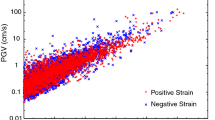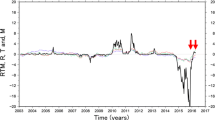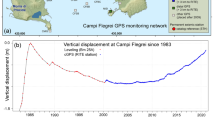Abstract
Accelerating rates of volcano-tectonic (VT) earthquakes are commonly observed during volcanic unrest. Understanding the repeatability of their behaviour is essential to evaluating their potential to forecast eruptions. Quantitative eruption forecasts have focused on changes in precursors over intervals of weeks or less. Previous studies at basaltic volcanoes in frequent eruption, such as Kilauea in Hawaii and Piton de La Fournaise on Réunion, suggest that VT earthquake rates tend to follow a power-law acceleration with time about 2 weeks before eruption, but that this trend is often obscured by random fluctuations (or noise) in VT earthquake rate. These previous studies used a stacking procedure, in which precursory sequences for several eruptions are combined to enhance the signal from an underlying acceleration in VT earthquake rate. Such analyses assume a common precursory trend for all eruptions. This assumption is tested here for the 57 eruptions and intrusions recorded at Kilauea between 1959 and 1984. Applying rigorous criteria for selecting data (e.g. maximum depth; restricting magnitudes to be greater than the completeness magnitude, 2.1), we find a much less pronounced increase in the aggregate rate of earthquakes than previously reported. The stacked trend is also strongly controlled by the behaviour of one particular pre-eruptive sequence. In contrast, a robust signal emerges among stacked VT earthquake rates for a subset of the eruptions and intrusions. The results are consistent with two different precursory styles at Kilauea: (1) a small proportion of eruptions and intrusions that are preceded by accelerating rates of VT earthquakes over intervals of weeks to months and (2) a much larger number of eruptions that show no consistent increase until a few hours beforehand. The results also confirm the importance of testing precursory trends against data that have been filtered according to simple constraints on the spatial distribution and completeness magnitude of the VT earthquakes.












Similar content being viewed by others
References
Bell AF, Kilburn CRJ (2011) Precursors to dyke-fed eruptions at basaltic volcanoes: insights from patterns of volcano-tectonic seismicity at Kilauea volcano, Hawaii. Bull Volcanol 74(2):325–339
Bell AF, Greenhough J, Heap MJ, Main IG (2011a) Challenges for forecasting based on accelerating rates of earthquakes at volcanoes and laboratory analogues. Geophys J Int. doi:10.1111/j.1365-246X.2011.04982.x
Bell AF, Naylor M, Heap MJ, Main IG (2011b) Forecasting volcanic eruptions and other material failure phenomena: an evaluation of the failure forecast method. Geophys Res Lett 38. doi:10.1029/2011gl048155
Chastin SFM, Main IG (2003) Statistical analysis of daily seismic event rate as a precursor to volcanic eruptions. Geophys Res Lett 30(13):1671. doi:10.1029/2003GL016900
Collombet M, Grasso JR, Ferrazzini V (2003) Seismicity rate before eruptions on Piton de la Fournaise volcano: implications for eruption dynamics. Geophys Res Lett 30(21). doi:10.1029/2003GL017494
De la Cruz-Reyna S, Reyes-Davila GA (2001) A model to describe precursory material-failure phenomena: applications to short-term forecasting at Colima volcano, Mexico. Bull Volcanol 63(5):297–308. doi:10.1007/s004450100152
Hardebeck JL, Felzer KR, Michael AJ (2008) Improved tests reveal that the accelerating moment release hypothesis is statistically insignificant. J Geophys Res Solid Earth 113(B08310). doi:10.1029/2007JB005410
Jones LM, Molnar P (1979) Some characteristics of foreshocks and their possible relationship to earthquake prediction and premonitory slip on faults. J Geophys Res 84(B7):3596
Kilburn CRJ (2003) Multiscale fracturing as a key to forecasting volcanic eruptions. J Volcanol Geotherm Res 125(3–4):271–289. doi:10.1016/S0377-0273(03)00117-3
Klein FW (1984) Eruption forecasting at Kilauea volcano, Hawaii. J Geophys Res 89(NB5):3059–3073
Klein FW, Koyanagi RY, Nakata JS, Tanigawa WR, Decker RW, Wright TL, Stauffer PH (1987) The seismicity of Kilauea's magma system. In: Volcanism in Hawaii. pp 1019–1185
Lengliné O, Marsan D, Got JL, Pinel V, Ferrazzini V, Okubo PG (2008) Seismicity and deformation induced by magma accumulation at three basaltic volcanoes. J Geophys Res Solid Earth 113(B12):12. doi:10.1029/2008JB005937
Maeda K (1999) Time distribution of immediate foreshocks obtained by a stacking method. Pure Appl Geophys 155(2–4):381–394
Main IG (1999) Applicability of time-to-failure analysis to accelerated strain before earthquakes and volcanic eruptions. Geophys J Int 139(3):F1–F6
McGuire JJ, Boettcher MS, Jordan TH (2005) Foreshock sequences and short-term earthquake predictability on East Pacific Rise transform faults. Nature 434(7032):457–461
Nakata J (2006) Hawaiian volcano observatory seismic data, January to December 2005. U.S. Geological Survey Open-File Report 122
Smith R, Kilburn CRJ, Sammonds PR (2007) Rock fracture as a precursor to lava dome eruptions at Mount St Helens from June 1980 to October 1986. Bull Volcanol 69(6):681–693. doi:10.1007/s00445-006-0102-5
Soosalu H, Einarsson P, Porbjarnardottir BS (2005) Seismic activity related to the 2000 eruption of the Hekla volcano, Iceland. Bull Volcanol 68(1):21–36. doi:10.1007/s00445-005-0417-7
Tilling RI, Dvorak JJ (1993) Anatomy of a basaltic volcano. Nature 363(6425):125–133
Voight B (1988) A method for prediction of volcanic eruptions. Nature 332(6160):125–130
Voight B (1989) A relation to describe rate-dependent material failure. Science 243(4888):200–203
Wiemer S, Wyss M (2000) Minimum magnitude of completeness in earthquake catalogs: examples from Alaska, the Western United States, and Japan. Bull Seismol Soc Am 90(4):859–869. doi:10.1785/0119990114
Zobin VM, Luhr JF, Taran YA, Breton M, Cortes A, De La Cruz-Reyna S, Dominguez T, Galindo I, Gavilanes JC, Muniz JJ, Navarro C, Ramirez JJ, Reyes GA, Ursua M, Velasco J, Alatorre E, Santiago H (2002) Overview of the 1997–2000 activity of Volcan de Colima, Mexico. J Volcanol Geotherm Res 117(1–2):1–19. doi:10.1016/s0377-0273(02)00232-9
Acknowledgments
This research was funded by the UK Natural Environment Research Council (AFB). During writing, AFB was funded by NERC project Ne/H02297x/1. We thank the USGS Hawaiian Volcano Observatory for access to the Hawaiian earthquake catalogue, Ian Main for helpful discussions and Phil Dawson and an anonymous reviewer for their constructive comments.
Author information
Authors and Affiliations
Corresponding author
Additional information
Editorial responsibility: T. Ohminato
Rights and permissions
About this article
Cite this article
Bell, A.F., Kilburn, C.R.J. Trends in the aggregated rate of pre-eruptive volcano-tectonic seismicity at Kilauea volcano, Hawaii. Bull Volcanol 75, 677 (2013). https://doi.org/10.1007/s00445-012-0677-y
Received:
Accepted:
Published:
DOI: https://doi.org/10.1007/s00445-012-0677-y




